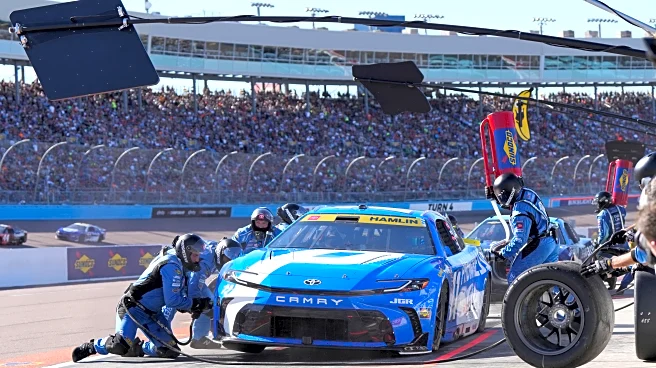What's Happening?
NASCAR has announced significant changes to its eligibility rules for the 2026 season, affecting its three national touring series. Competitors who have raced full-time in the Cup Series for more than
three years will be allowed to participate in up to 10 races in the O'Reilly Auto Parts Series, formerly known as the Xfinity Series, doubling the current limit. Additionally, Cup competitors can enter eight events in the Craftsman Truck Series, an increase of three races. However, Cup drivers remain ineligible for regular-season finales and post-season races in these series. The changes aim to increase participation and draw more attention to these events, while also providing younger drivers with more opportunities to develop their skills. NASCAR is also lowering the minimum age requirement for the O'Reilly Auto Parts Series to 17 for certain tracks and the Craftsman Truck Series to 16, while the Cup Series entry age remains at 18.
Why It's Important?
These rule changes are significant for several reasons. Allowing more Cup Series drivers to participate in lower-tier series can increase the visibility and popularity of these events, potentially boosting ticket sales and viewership. This could also lead to increased revenue for NASCAR and its teams. Moreover, lowering the age requirements for participation in the O'Reilly Auto Parts and Craftsman Truck Series opens the door for younger talent to enter the sport earlier, which could diversify the pool of drivers and attract a younger fan base. However, these changes may also impact smaller teams financially, as Cup teams often have more resources and can dominate these series, potentially overshadowing full-time competitors.
What's Next?
As NASCAR implements these changes, stakeholders such as team owners, drivers, and fans will likely react and adapt to the new rules. Teams may strategize differently, considering the increased participation of Cup drivers in lower-tier series. Young drivers and their families might prepare for earlier entry into professional racing, which could involve adjustments in training and development programs. Fans may express mixed feelings, as some appreciate seeing their favorite Cup drivers more frequently, while others may be concerned about the impact on smaller teams. NASCAR will need to monitor these dynamics closely to ensure the changes achieve their intended goals without unintended negative consequences.
Beyond the Headlines
The decision to lower age requirements and increase Cup driver participation in lower-tier series reflects NASCAR's ongoing efforts to modernize and appeal to a broader audience. By embracing younger drivers, NASCAR is positioning itself to capture the interest of a new generation of fans, which is crucial for the sport's long-term growth and sustainability. Additionally, these changes may influence the cultural perception of racing, as younger drivers bring fresh perspectives and styles to the sport. NASCAR's role in shaping the future of stock car racing will be closely watched as these new rules take effect.













